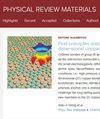Direct evidence of induced magnetic moment in Se and the role of misplaced Mn in MnBi2Se4-based intrinsic magnetic topological insulator heterostructures
IF 3.1
3区 材料科学
Q2 MATERIALS SCIENCE, MULTIDISCIPLINARY
引用次数: 0
Abstract
Intrinsic magnetic topological insulators, in which magnetism and topology are inherently combined, are excellent systems to realize exotic phenomena such as the quantum anomalous Hall effect. However, there are many reports that show that the experimental samples are not so ideal and the effect of the unintentional disorder in these systems needs to be considered carefully. In this study, we investigate the role of misplaced magnetic atoms as well as nonmagnetic elements in the intrinsic magnetic topological insulator heterostructures based on and . We find that Mn atoms are not only placed at the central layer of the septuple layer (SL) but also intermix with Bi (antisite Mn) as well as reside in the van der Waals (vdW) gap. Through a detailed comparison between the experimental and theoretical x-ray magnetic circular dichroism (XMCD) spectra, we find that the antisite Mn is coupled ferromagnetically, whereas the vdW Mn couple antiferromagnetically to the Mn in the central atomic plane of the SL. Furthermore, we detect a clear XMCD signal in nonmagnetic Se, providing unambiguous evidence of its magnetic interaction with Mn.

基于 MnBi2Se4 的本征磁性拓扑绝缘体异质结构中 Se 诱导磁矩的直接证据和错位锰的作用
本征磁性拓扑绝缘体是磁性和拓扑结构的内在结合,是实现量子反常霍尔效应等奇异现象的绝佳系统。然而,许多报告显示,实验样品并不那么理想,需要仔细考虑这些系统中无意无序的影响。在本研究中,我们研究了错位磁性原子以及非磁性元素在基于 MnBi2Se4 和 Bi2Se3 的本征磁性拓扑绝缘体异质结构中的作用。我们发现,锰原子不仅位于 MnBi2Se4 七元层(SL)的中心层,而且还与 Bi(反位锰)混合,并存在于范德华(vdW)间隙中。通过详细比较实验和理论 X 射线磁圆二色性(XMCD)光谱,我们发现反钴锰是铁磁耦合的,而 vdW 锰与 SL 中央原子面上的锰是反铁磁耦合的。此外,我们还在非磁性硒中检测到了清晰的 XMCD 信号,为其与锰的磁性相互作用提供了明确的证据。
本文章由计算机程序翻译,如有差异,请以英文原文为准。
求助全文
约1分钟内获得全文
求助全文
来源期刊

Physical Review Materials
Physics and Astronomy-Physics and Astronomy (miscellaneous)
CiteScore
5.80
自引率
5.90%
发文量
611
期刊介绍:
Physical Review Materials is a new broad-scope international journal for the multidisciplinary community engaged in research on materials. It is intended to fill a gap in the family of existing Physical Review journals that publish materials research. This field has grown rapidly in recent years and is increasingly being carried out in a way that transcends conventional subject boundaries. The journal was created to provide a common publication and reference source to the expanding community of physicists, materials scientists, chemists, engineers, and researchers in related disciplines that carry out high-quality original research in materials. It will share the same commitment to the high quality expected of all APS publications.
 求助内容:
求助内容: 应助结果提醒方式:
应助结果提醒方式:


